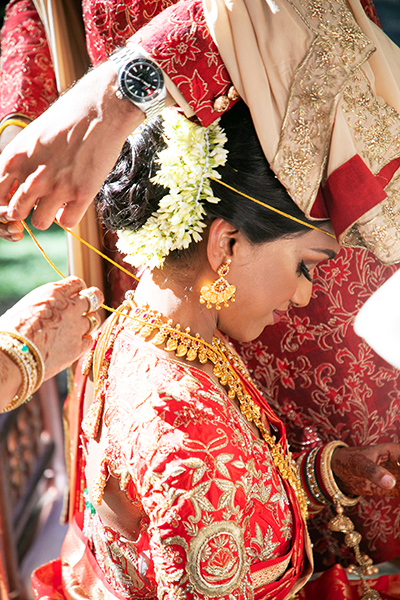 “Tying the Thali” is a significant ritual in South Indian Hindu weddings, particularly in Tamil Nadu and Kerala. It involves the groom tying a sacred thread or yellow cord, known as the “Thali” or “Mangalyam,” around the bride’s neck. Here’s an overview of the ceremony:
“Tying the Thali” is a significant ritual in South Indian Hindu weddings, particularly in Tamil Nadu and Kerala. It involves the groom tying a sacred thread or yellow cord, known as the “Thali” or “Mangalyam,” around the bride’s neck. Here’s an overview of the ceremony:
Preparation: The Thali is a pendant or locket with auspicious symbols or religious motifs, often made of gold. It is usually prepared beforehand and blessed by a priest.
Blessing of the Thali: Prior to the ceremony, the Thali is sanctified by performing a puja (ritual worship) to invoke the blessings of the deities. The Thali is considered sacred and symbolizes the marital bond.
Exchange of Garlands: As a precursor to Tying the Thali, the bride and groom exchange floral garlands, known as “Maalai,” as a symbol of acceptance and mutual respect.
Tying the Thali: The groom, with the assistance of a priest or an elder family member, ties the Thali around the bride’s neck. The Thali is positioned near the heart, representing the bond of love, commitment, and lifelong unity between the couple.
Mantras and Blessings: During the Thali tying ceremony, the priest or officiant recites sacred verses or mantras, invoking blessings from the deities for the couple’s prosperous and harmonious married life.
Witnessing and Applause: Family members, relatives, and guests witness the Tying the Thali ceremony, and it is often met with applause and joyous celebration.
.jpg) Sindoor Application: Following the Thali ceremony, the groom applies sindoor (vermilion powder) on the bride’s hair parting. This act symbolizes her marital status and marks the completion of the wedding rituals.
Sindoor Application: Following the Thali ceremony, the groom applies sindoor (vermilion powder) on the bride’s hair parting. This act symbolizes her marital status and marks the completion of the wedding rituals.
The Tying the Thali ritual signifies the formalization of the marriage bond between the bride and groom. It represents their commitment, love, and mutual respect for each other, and it is a significant moment in the wedding ceremony.
The Thali holds immense cultural and religious significance, and the ceremony itself varies based on regional customs and family traditions. The exact design of the Thali, the accompanying rituals, and the specific mantras recited may differ across different communities within South India.
The Tying the Thali ceremony serves as a sacred and memorable moment, symbolizing the beginning of the couple’s lifelong journey together as husband and wife.







